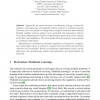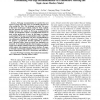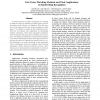310 search results - page 53 / 62 » MuFeSaC: Learning When to Use Which Feature Detector |
ECAL
2005
Springer
14 years 1 months ago
2005
Springer
Abstract. Inspired by the recent advances in evolutionary biology, we have developed a self-organising, self-adaptable cellular system for multitask learning. The main aim of our p...
EUROCAST
2003
Springer
14 years 1 months ago
2003
Springer
Computer vision tasks such as learning, recognition, classification or segmentation applied to spatial data often requires spatial normalization of repeated features and structure...
ATAL
2007
Springer
14 years 2 months ago
2007
Springer
Activity recognition is a key component for creating intelligent, multi-agent systems. Intrinsically, activity recognition is a temporal classification problem. In this paper, we...
ICDM
2010
IEEE
13 years 5 months ago
2010
IEEE
Web-page recommendation is to predict the next request of pages that Web users are potentially interested in when surfing the Web. This technique can guide Web users to find more u...
ICDAR
2005
IEEE
14 years 1 months ago
2005
IEEE
A common practice in pattern recognition is to classify an unknown object by matching its feature vector with all the feature vectors stored in a database. When the number of clas...



